Milly White's Blog, page 55
August 14, 2015
7 Top Tips to Canny Food Shopping for One or Two
 There has been a lot of debate in the news over the last few years about the amount of food waste generated by supermarket “saver” deals such as buy one, get one free. Figures reported in 2013 in the UK indicated that:
There has been a lot of debate in the news over the last few years about the amount of food waste generated by supermarket “saver” deals such as buy one, get one free. Figures reported in 2013 in the UK indicated that: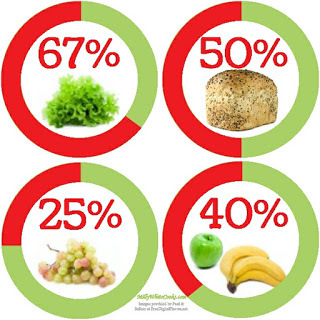 Food Waste
Food Waste67% of bagged salad leaves50% of bakery goods 25% of grapes40% of bananas and applesare discarded and thrown away uneaten each year (link: The Guardian Food Waste). It can be difficult enough when shopping for a large family to avoid such waste but it is harder still for smaller households. I'm sure we've all had occasion to end up throwing away what had been perfectly good food, but despite our best intentions, we'd just not eaten it in time. However don't despair, you can avoid unnecessary waste especially if you adopt my 7 Top Tips to Canny Food Shopping for One or Two.
1 Loose produce is your friend!
 For fresh fruit and vegetables, the key here is to eschew pre-packed bags and containers where-ever possible. Don’t be afraid to buy just a single carrot, pepper or courgette/zucchini if that is all you need. You will be surprised to learn that not only will you save money from not buying more than you need, loose produce is also often cheaper gram-for-gram (lb-for-lb) than the packaged equivalent. Here’s a snapshot of price comparisons that I researched for this book (prices taken in Feb 2015):
For fresh fruit and vegetables, the key here is to eschew pre-packed bags and containers where-ever possible. Don’t be afraid to buy just a single carrot, pepper or courgette/zucchini if that is all you need. You will be surprised to learn that not only will you save money from not buying more than you need, loose produce is also often cheaper gram-for-gram (lb-for-lb) than the packaged equivalent. Here’s a snapshot of price comparisons that I researched for this book (prices taken in Feb 2015):Pre-packed 500g (1.1lb) bag of parsnips were 32% more expensive per kilo than the loose parsnipsPre-packed 600g (1.3lb) bag of carrots were 11% more expensive per kilo than the loose carrotsPre-packed 500g (1.1lb) bag of courgette/zucchini were 40% more expensive per kilo than the loose courgette/zucchiniPre-packed 650g (1.4lb) bag of apples were 15% more expensive per kilo than the loose apples
2 Stock your freezer!
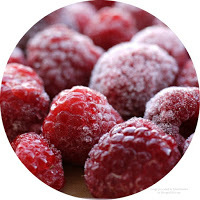 When being used as an ingredient mixed into a recipe, it is unlikely that you will taste any difference whatsoever between frozen vegetables or fruits vs fresh. Additionally, as fruit and vegetables are frozen very soon after being harvested (which occurs at their peak in ripeness), they retain their nutritional goodness versus fresh produce which has been transported and stored for long periods. Frozen options are particularly useful for fruit and vegetables that you are unable to easily buy in the loose format described above, such as most berries, spinach, peas and beans. You should also be aware that when you are buying “fresh” prawns/shrimps or seafood from the fish section, it has probably actually been previously frozen then defrosted. Skip that step and buy the frozen version directly.
When being used as an ingredient mixed into a recipe, it is unlikely that you will taste any difference whatsoever between frozen vegetables or fruits vs fresh. Additionally, as fruit and vegetables are frozen very soon after being harvested (which occurs at their peak in ripeness), they retain their nutritional goodness versus fresh produce which has been transported and stored for long periods. Frozen options are particularly useful for fruit and vegetables that you are unable to easily buy in the loose format described above, such as most berries, spinach, peas and beans. You should also be aware that when you are buying “fresh” prawns/shrimps or seafood from the fish section, it has probably actually been previously frozen then defrosted. Skip that step and buy the frozen version directly.3 Save money by paying more! Now this is the exact opposite of point 1. Whereas with fruit and vegetables it is often the case that buying smaller, loose quantities works out cheaper pro-rata than the pre-packaged equivalents, that option is not available for items that have to be bought packaged (such as milk or yogurt). Really try to keep to the discipline of only buying quantities appropriate to your needs. It may be cheaper per yogurt to buy the dozen multi-pack, but if you are only going to eat 4 before the use-by date, then you haven’t actually made a saving at all. Get into the habit of buying smaller containers of food which perishes quickly and that cannot be frozen.
4 Count on Counters! If you are able to, source your meat and fish from the local butcher and fishmonger. If you need to do all your food shopping in the supermarket rather than smaller stores, then make a point to visit their speciality food counters. This tip particularly applies to meat and fish. For a start, in the pre-packed food aisles, it can be hard not to be sucked into the bulk-purchase offers (buy 1 get 1 free, buy the value pack). Secondly, at the counter you can buy exactly the quantity that you require and no more, such as two chicken breasts or fish fillets.
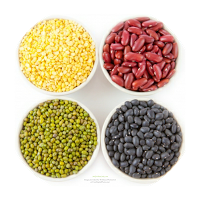 5 More Can Be Good! Don’t be afraid to bulk-buy long-life items that you use often such as dried beans, rice, seeds, nuts, flour. However, do invest in good quality, air-tight storage to keep these items stored well. A word of caution, though,
if you have food intolerances
such as gluten or nuts, I
do not recommend buying in bulk from dry good bulk bins in grocery stores
, even for foods which should naturally be free from the allergen, due to the danger of cross-contamination.
5 More Can Be Good! Don’t be afraid to bulk-buy long-life items that you use often such as dried beans, rice, seeds, nuts, flour. However, do invest in good quality, air-tight storage to keep these items stored well. A word of caution, though,
if you have food intolerances
such as gluten or nuts, I
do not recommend buying in bulk from dry good bulk bins in grocery stores
, even for foods which should naturally be free from the allergen, due to the danger of cross-contamination. 6 Grow a herb and salad garden! For those without green fingers or a garden space, I’m not necessarily advocating any real gardening, but cut herbs and salad leaves will have the shortest shelf-life of any ingredient that you buy. So instead, keep a few pots of the fresh herbs that you use most often on your kitchen window sill. Often these days you can also buy a little container growing different salad leaves. In both cases, you are able to just harvest the amount you need for your recipe, even if you are not at all green fingered.
6 Grow a herb and salad garden! For those without green fingers or a garden space, I’m not necessarily advocating any real gardening, but cut herbs and salad leaves will have the shortest shelf-life of any ingredient that you buy. So instead, keep a few pots of the fresh herbs that you use most often on your kitchen window sill. Often these days you can also buy a little container growing different salad leaves. In both cases, you are able to just harvest the amount you need for your recipe, even if you are not at all green fingered.7 Divide & Conquer! Finally, as will always be the case some of the time, you may find you have a surplus of either a raw ingredient or a finished dish. Don’t just cover with kitchen film and leave it in the fridge, only to throw it away a week later. Instead, divide it into suitable portions and freeze it as soon as possible, preferably on the day you bought it. Be mindful that once frozen, foods are hard to separate, so divide it up into manageable, separated portions before freezing. For example, use kitchen parchment to separate rashers of bacon or tortilla wraps before placing them in a freezer bag. Wrap steaks, chops, chicken breasts and portions of minced/ground meat into individual freezer bags. Make sure you label what you’re freezing and when it should be used by.
Cook Vibrant, Nutritious, Fresh Food That's Just Enough For Two!
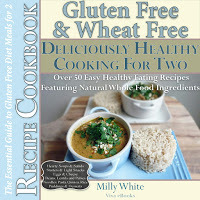 Many cookbooks feature recipes that provide 4 or 6 servings as standard. For smaller households, preparing delicious meals suitable for two is not as easy as just dividing such recipes by 2 or 3. Firstly, when cooking, you probably don’t want a math test at the same time! Secondly, it’s often not even that straight-forward, as:
Many cookbooks feature recipes that provide 4 or 6 servings as standard. For smaller households, preparing delicious meals suitable for two is not as easy as just dividing such recipes by 2 or 3. Firstly, when cooking, you probably don’t want a math test at the same time! Secondly, it’s often not even that straight-forward, as:how exactly do you halve an egg?how much liquid/stock should you include?how long should you cook something for?what size dish should you use?My 'Deliciously Healthy Cooking For Two' Cookbook eliminates that hard work with tried and tested recipes, perfectly scaled to serve two and gluten free too ! You won’t have the dilemma of what to do with left-overs, you can still enjoy healthier desserts and you won’t have the fridge or cupboards crammed with half-used ingredients.
Take a Peek at this Video Preview
You can find this cookbook as a paperback and Kindle book on Amazon:<br /> <br /> And in ebook format from



Published on August 14, 2015 07:12
August 7, 2015
9 Fantastic Foods to Feed Your Brain on the Mediterranean Diet (Infographic)
 Studies have repeatedly linked the Mediterranean Diet with numerous health benefits including lower cholesterol and a healthy heart. Were you aware that research has also found that it can play a role in
keeping your brain healthy as you age
(link: The Journal of the American Medical Association 2009;302(6))?
Studies have repeatedly linked the Mediterranean Diet with numerous health benefits including lower cholesterol and a healthy heart. Were you aware that research has also found that it can play a role in
keeping your brain healthy as you age
(link: The Journal of the American Medical Association 2009;302(6))?The Mediterranean Diet is a natural, whole-food diet rich in fresh vegetables, fruit, whole grains, seeds, fish and olive oils and low in animal-sourced saturated fat, dairy and red meat. As such, it is high in antioxidant and anti-inflammatory nutrients and these in particular have been associated with helping to prevent cognitive decline in older age . Further research has also found that when older adults supplemented their Mediterranean Diet specifically with nuts and extra olive oil, they had superior cognitive and memory skills than those who ate a reduced-fat diet (link: The Journal of the American Medical Association Internal Medicine 2015;175(7)).
9 Fantastic Foods to Feed Your Brain on the Mediterranean Diet
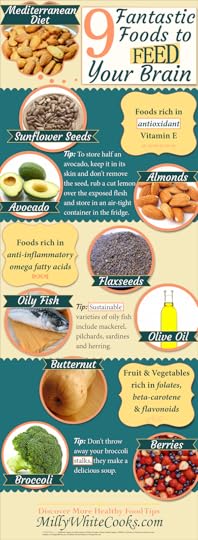
The great news is that the natural foods within the Mediterranean Diet that are most beneficial to brain health are all delicious. They are so abundant that even if you have special diertary requirements, there is still plenty of choice even if you need to avoid certain food groups (such as nuts, gluten, dairy) or are a vegetarian. These brain-healthy superfoods fall into three main groupings:
Brain-Health Superfoods Group 1: Antioxidants Sunflower seeds rich in the antioxidant Vitamin EWalnuts, hazelnuts and almonds rich in the antioxidantsAvocado rich in the antioxidant Vitamin E
Brain-Health Superfoods Group2 : Anti-inflammatory Omega Fatty AcidsOlive Oil, specifically Extra Virgin Olive Oil, rich in anti-inflammatory oleocanthal compoundsOily Fish such as salmon, mackerel, pilchards, sardines and herring which are rich in Omega-3 fatty acidsFlax seed (linseed) rich in anti-inflammatory Alpha-Linolenic Acid
Brain-Health Superfoods Group 3: Fruit & Vegetables rich in folates, beta-carotene & flavonoidsBroccoli and other dark green leafy vegetables rich in folatesButternut Squash & Pumpkin rich in beta-caroteneBlueberries & strawberries high in flavonoidsFurther InspirationIf you're looking easy ways to follow the Mediterranean Diet, then you may want to checkout my best-selling Easy Low Fat & Low Cholesterol Mediterranean Diet Recipe Cookbook which features over 100 easy, tasty everyday recipes:



Published on August 07, 2015 11:43
July 26, 2015
12 Delicious Ways to Eat Gluten-Free on a Budget & 15 Top Tips & Tricks to Save Money Going Wheat-Free
 If you or someone you cook for needs to follow a gluten-free diet, you’ll already be well aware that very often shop-bought gluten-free prepared foods and/or ingredients are only available at a hefty price premium. It can be quite tricky ensuring that meals are gluten-free, especially as the typical, modern “Western-diet” is heavily centred on gluten-rich products, such as bread, flour and pasta. This in itself can be a big enough worry, but on top of that, it can also be ridiculously expensive! However, it doesn't need to be this way, so take a look at my 12 Delicious Ways to Eat Gluten-Free on a Budget & 15 Top Tips & Tricks to Save Money Going Wheat-Free.
If you or someone you cook for needs to follow a gluten-free diet, you’ll already be well aware that very often shop-bought gluten-free prepared foods and/or ingredients are only available at a hefty price premium. It can be quite tricky ensuring that meals are gluten-free, especially as the typical, modern “Western-diet” is heavily centred on gluten-rich products, such as bread, flour and pasta. This in itself can be a big enough worry, but on top of that, it can also be ridiculously expensive! However, it doesn't need to be this way, so take a look at my 12 Delicious Ways to Eat Gluten-Free on a Budget & 15 Top Tips & Tricks to Save Money Going Wheat-Free.The Gluten-Free Price Premium
Whilst the rise in awareness of gluten-triggered autoimmune diseases such as Celiac/Coeliac Disease or Dermatitis Herpetiformis has resulted in an increase in gluten-free food options, unfortunately, these come at quite a significant price premium. For example, I recently compared the prices of the gluten-free alternatives to their regular, gluten-containing equivalent and I found the following:
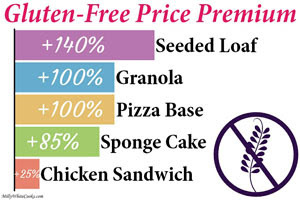 • that a Gluten-Free Seeded Loaf cost 100%-140% more than the “standard” Seeded Loaf
• that a Gluten-Free Seeded Loaf cost 100%-140% more than the “standard” Seeded Loaf• that Gluten-Free Granola cost over 100% more per portion than the “standard” Granola
• that a pack of two Gluten-Free Pizza Bases cost 100% more than the same brand “standard” Pizza Bases
• that the Gluten-Free Victoria Sponge Cake version cost 85% more than the same brand “premium but gluten-containing” Victoria Sponge Cake
• that the Gluten-Free Chicken Salad Sandwich cost 25% more than the “standard” Chicken Salad Sandwich.
Lack of Variety & Choice in Gluten Free Options
Although in the UK, gluten-free staple foods (such as bread, breakfast cereals, pasta and pizza bases) are available on prescription for anyone diagnosed with Coeliac disease or Dermatitis Herpetiformis, it remains the case that there is also much less variety and choice in the gluten-free aisle. For example, on a recent trip to the supermarket, I noted that there were over 40 different varieties of “standard” Granola , but just 4 varieties of Gluten-Free Granola . There was definitely a lack of excitement and inventiveness in the flavours and varieties of gluten-free prepared foods on offer in the stores. There was also a significant bias to sweet baked goods such as cookies, biscuits and cakes.
More worryingly, the food industry has shown a tendency to rely heavily on nutritionally-poor substitutions with their “gluten-free” alternatives, relying on ingredients such as:
nutritionally-poor white rice flourhighly processed ingredients that have lost their natural whole-food goodnessincreased quantities of fat, sugar and/or salt to compensate for the lack of flavour normally provided by wheatreliance on e-numbers and chemical stabilisers to provide structure and stability.
When questioned, taste and/or expense are the most often cited reasons why people do not buy a gluten-free product. The good news, though, is that following a gluten-free diet doesn’t have to be:
| E xpensive | Dull | boring | Time-consuming | Difficult |My 12 Delicious Ways to Eat Gluten-Free on a Budget (& 15 Top Tips & Tricks)
1. Base your meals around naturally gluten-free ingredients.
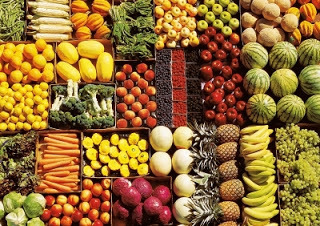 Foods that are Naturally Gluten-Free
Foods that are Naturally Gluten-FreeImage courtesy of xedos4 at FreeDigitalPhotos.netAlthough this may not seem to be the case when reading the labels on processed foods in the grocery store, there are many healthy, delicious, nutritious and inexpensive foods that are naturally gluten-free. Focus on the fresh food aisles including seasonal fruits and vegetables, eggs, economical cuts of meat and fish. In the grocery section, think about beans, pulses, lentils, brown rice, wheat-free grains such as quinoa, low saturated-fat oils, seeds, nuts, herbs and spices.
2. Be Flexible & Open-MindedI’m not suggesting you’re not flexible or open-minded, what I’m trying to say here is about instead of trying to recreate an exact but gluten-free copy of something , be prepared to enjoy something similar but slightly changed . For example, instead of having a sandwich for lunch at work every day, what about soup or salad or open-topped oatcakes? Instead of pasta for dinner 2-3 times a week, what about a rice-noodle stir-fry, or curry and rice? It’s generally cheaper when you can substitute a gluten-containing ingredient for an alternative that is naturally gluten-free, rather than a substitute that has been specifically manufactured to be gluten-free.
3. Invest a bit a time and learn some core skills
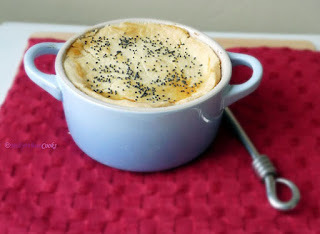 Gluten-Free Pastry Sweet Potato Here's a bit of a statement of the blinking obvious, but I think you’ll have guessed that I love to cook and bake! Therefore, for me, stepping into the kitchen and rustling up gluten-free bread, cakes, pastry etc is a joy not a penance. However, I do totally appreciate that not everyone feels the same! That said,
it is worth the time learning how to cook half a dozen basic gluten-free recipes
. My recommendations would be:
Gluten-Free Pastry Sweet Potato Here's a bit of a statement of the blinking obvious, but I think you’ll have guessed that I love to cook and bake! Therefore, for me, stepping into the kitchen and rustling up gluten-free bread, cakes, pastry etc is a joy not a penance. However, I do totally appreciate that not everyone feels the same! That said,
it is worth the time learning how to cook half a dozen basic gluten-free recipes
. My recommendations would be:a basic gluten-free pastry recipea basic gluten-free bread loaf or roll recipea gluten-free meatball or meatloaf recipea gluten-free chicken and/or vegetable stock recipea gluten-free granola or muesli recipe (you won’t believe just how easy this is)if you have a sweet tooth, a gluten-free cupcake, cookie or dessert recipe.If you are a keen cook, you’ll probably already have these under your belt, but if you are not, then rather than thinking you need to turn into a gluten-free Julia Childs, just conquer a few key gluten-free recipes that will hold you in good stead and help keep down your gluten-free food bill. For lots of gluten-free recipe inspiration:
Discover how you can download a FREE copy of my Gluten-Free Meals for All Occasions Recipe Booklet here.
4. Buy in Bulk and/or Online
Some ingredients that can be staples in a gluten-free kitchen can also be hard to find in a small grocery store or if you do not have access to a health-food store locally. Here I’m thinking of gluten-free grains such as quinoa, seeds, nuts and dried fruits. It can often be more economical to pay the shipping charges on a single comprehensive online order once a month or quarter than spend the time and petrol costs involved in trying to track down those ingredients from local speciality stores on a weekly basis.
5. Buy a Slow-Cooker
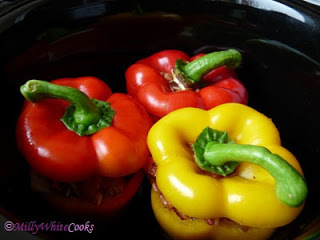 I am such a fan of slow-cookers. First of all, they are so very good at turning inexpensive cuts of meat into a bowl of flavoursome, tender deliciousness. Secondly, a slow cooker will become your BFF if you work long days and want to be able to eat within minutes of getting in the door at night. Instead of coming home and having to start cooking, you’ll be greeted with a mouth-watering aroma as soon as you walk in the door and all you need to do is warm the plates before serving up. Slow-cookers are inexpensive to buy and cheap to run.
I am such a fan of slow-cookers. First of all, they are so very good at turning inexpensive cuts of meat into a bowl of flavoursome, tender deliciousness. Secondly, a slow cooker will become your BFF if you work long days and want to be able to eat within minutes of getting in the door at night. Instead of coming home and having to start cooking, you’ll be greeted with a mouth-watering aroma as soon as you walk in the door and all you need to do is warm the plates before serving up. Slow-cookers are inexpensive to buy and cheap to run.6. Make Friends with Your Freezer Part 1
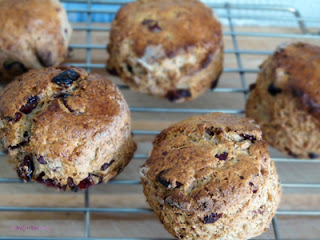 Did you know that with baked goods, it’s better if you freeze them uncooked rather than already cooked? It’s perfectly easy to freeze cupcakes, scones, cookies, pastry etc, and then just bake off the quantity you need as you go. Here’s 5 Tips on how to do this:
Did you know that with baked goods, it’s better if you freeze them uncooked rather than already cooked? It’s perfectly easy to freeze cupcakes, scones, cookies, pastry etc, and then just bake off the quantity you need as you go. Here’s 5 Tips on how to do this:for scones, make up your scone mixture and cut out the scones. Place onto a baking sheet or tray that will fit into your freezer and freeze uncovered for 2 hrs. Once frozen through, remove from the tray and place into freezer bags or container. To bake, remove the quantity that you need from the freezer about 1 hr before cooking (or overnight) to defrost, and bake according to the recipe instructions.for cupcakes, make up the cake mixture and spoon into cupcake cases placed into a cupcake baking tray that will fit into your freezer and freeze uncovered for 2 hrs. . Once frozen through, either cover the tray in kitchen foil to seal or remove the cupcakes in their cases from the tray and place in a single layer into freezer bags or container. To bake, remove the quantity that you need from the freezer about 1 hr before cooking (or overnight) and place back into the cupcake baking tray to defrost, then bake according to the recipe instructions.for cookies, if the cookie dough is a “firm” raw mixture recipe, then roll the mixture into a log, slice and interleave the slices with baking parchment before freezing. Alternatively, roll into golf-ball sized balls, freeze on an open tray then transfer to a freezer bag. If the cookie dough is a mixture that is a “soft” raw mixture, line a baking tray with will fit into the freezer with baking parchment. Drop on the spoonfuls of cookie mixture. Cover with a further layer of baking parchment and freeze. Once frozen, fold over the lines of cookies in their parchment layers and place into a freezer bag. To bake, remove the quantity that you need from the freezer about 1 hr before cooking (or overnight) to defrost, (defrosted balls can be squished flat before baking)and bake according to the recipe instructions.for pastry, divide the pastry into the required quantities and shape into a disc. Place each disc in a freezer bag. When needed, defrost in the fridge overnight or at room temperature for 3 hrs before using.for desserts such as fruit crumbles or crisps, in a container that is both oven-proof and freezer-proof part cook them according to the recipe but remove from the oven 15-20 minutes early. For example, if the recipe states ‘cook for 45mins’ cook for 25mins then remove from the oven. Cool the dessert then cover with kitchen foil and freeze. Defrost thoroughly before cook at the recipe temperature for 25 mins.If you do need to freeze already baked items such as bread, rolls or cakes, you should do so as soon after buying as possible, preferably in individually wrapped portions. You can refresh defrosted bread, rolls and un-iced/frosted cakes/scones in a warm oven for a few minutes, to regain some of that “just baked” texture and aroma .
7. Make Friends with Your Freezer Part 2
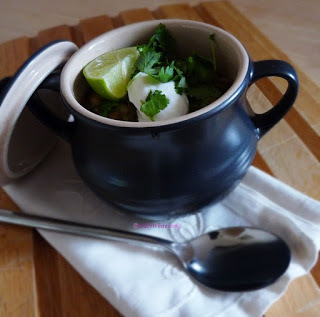 So above, I looked at the best way to freeze baked goods.
The freezer is also your friend for stocks, sauces and home-made “ready-meals”
. Often when I cook, I’ll double the quantity then freeze half for later. Here's 3 Tips on how to do this:
So above, I looked at the best way to freeze baked goods.
The freezer is also your friend for stocks, sauces and home-made “ready-meals”
. Often when I cook, I’ll double the quantity then freeze half for later. Here's 3 Tips on how to do this:For stocks, soups and sauces, I cook the recipe until the end, then cool half and freeze it. For home-made “ready-meals” it will depend upon the recipe at which point I’ll freeze it. For instance, for a baked dish such as moussaka or cottage pie, I will bake it for 20 mins less than the recipe states, cool it, cover it and freeze it. Then I’ll defrost before cooking at the recipe temperature for 25-30 mins until piping hot all the way through. For a slow cooker stew or casserole, I will cook it all the way through and just freeze what’s left over at the end of cooking.8. Make Friends with Your Freezer Part 3
Your freezer is also useful to keep fresh many ambient bulk ingredients that you may have purchased in Point 4 above. Check the Best Before dates on items such as seeds, nuts, gluten-free flour mixes etc as soon as you buy them. If you are not likely to use them in the time scale, pop them into resealable freezer bags and store in your freezer so that they stay at their best and are always to hand. I also do this for ground coffee. I don’t drink coffee at all but I like to be able to offer visitors a freshly brewed cup if that’s their beverage of choice, so I freeze it and can use it straight from the freezer, as required!
9. Use Up Left-Overs/Excess Ingredients
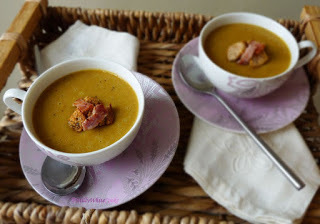 Whilst I’ve already suggested that it’s better to recognise in advance that you are not going to need all of an ingredient in advance, life happens and sometimes we’re left with something that’s about to go out of date. Here’s 7 of my top “use-it-up-not-lose-it” tips:
Whilst I’ve already suggested that it’s better to recognise in advance that you are not going to need all of an ingredient in advance, life happens and sometimes we’re left with something that’s about to go out of date. Here’s 7 of my top “use-it-up-not-lose-it” tips:Turn unwanted, stale gluten free bread into breadcrumbs and freeze for later use in meatballs or meatloaf.Alternatively, cube unwanted gluten free bread or rolls, sprinkle with olive oil and dried herbs and bake in the oven for about 15-20 mins until golden to make croutons. Cool and freeze.Use a rolling pin to crush gluten-free cookies into crumbs and freeze. Either use to make a gluten-free sweet pie crumble topping or just to sprinkle over fruit desserts or ice-cream.Use gluten-free sweet rolls to bake a decadent retro Bread & Butter Pudding.Roast left-over gluten-free sausages, cool, slice and freeze. Defrosted, these can then be added to homemade baked beans for a quick & tasty supper.Make a delicious gluten-free cheese sauce and fold in any left-over cooked gluten-free pasta. Divide into freezer trays and freeze individual portions of mac and cheese.Alternatively, toss left-over cooked gluten-free pasta in a homemade lemon and oil salad dressing. Add pinenuts, salad vegetables and olives, pop into a sealable container in the fridge and take to work the next day for a packed lunch.
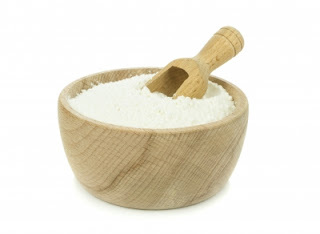 Image courtesy of Mister GC
Image courtesy of Mister GC at FreeDigitalPhotos.net10. Don’t Feel Guilty about Ready Blended Gluten-Free Flour Mixes
I don’t know about you, but often when I’m looking at gluten-free recipes online, it can seem that if you don’t have your own “signature” gluten-free flour blend, then you should hang your head in shame. Personally, I couldn’t disagree with this more strongly. If you are a regular and enthusiastic gluten-free baker with easy access to a variety of gluten-free flours, then mix away and come up with your own blend or blends, I’m certainly not advocating not to. However, if you are:
an occasional gluten-free baker, oran inexperienced gluten-free baker, ordo not have easy access to a variety of gluten-free flours
then use a widely-available, regular gluten-free branded blend without fear or guilt. There are two main reasons for this:
Firstly, these ready-blended mixes are now very widely available in almost all main supermarkets. Secondly, using just one all-purpose blend is also friendlier on the wallet for the occasional gluten-free baker rather than needing to buy 3-4 different gluten-free flours to make up their own blend.
 11. Sign-Up for E-Newsletters & Offers
11. Sign-Up for E-Newsletters & OffersFor many people, it’s just not practical to cook everything from scratch. Register online for newsletters and offers from your favourite gluten-free brands, you’ll be surprised at how often you’ll receive vouchers or coupons (even in the UK, where we don’t have as many coupons as our US cousins).
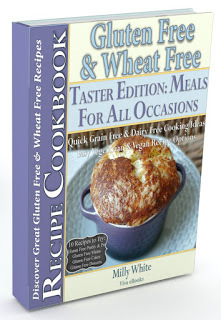 12. Download your FREE copy of my Gluten-Free Meals For All Occasions Recipe BookletDiscover this Taster Edition Recipe eBook which provides lots of inspiration for delicious, nutritious healthy gluten-free meals plus many feel-good favourites and treats for holidays and celebrations too. Each recipe is completely Gluten-Free and many are also:
12. Download your FREE copy of my Gluten-Free Meals For All Occasions Recipe BookletDiscover this Taster Edition Recipe eBook which provides lots of inspiration for delicious, nutritious healthy gluten-free meals plus many feel-good favourites and treats for holidays and celebrations too. Each recipe is completely Gluten-Free and many are also:| Dairy-Free | Oat-Free | Nut-Free | Vegetarian | Vegan | Yeast-Free |
You can download your FREE copy of my Gluten-Free Meals for All Occasions Recipe Booklet here.
So that's my 12 Delicious Ways to Eat Gluten-Free on a Budget & 15 Top Tips & Tricks to Save Money Going Wheat-Free, what tips do you have for economising on a gluten-free diet?
Published on July 26, 2015 04:14
July 15, 2015
Say Hello to Delicious Fast Diet Days on the Two Day 5:2 Diet Plan
 Delicious Fast Diet Days on The Two-Day 5:2 Diet Plan Have you heard about a diet plan which offers an effective solution to help you lose weight and improve your health, whilst still allowing you to eat all of the foods that you love? Say "hello" to the Two Day 5:2 Diet Plan! This diet is:
Delicious Fast Diet Days on The Two-Day 5:2 Diet Plan Have you heard about a diet plan which offers an effective solution to help you lose weight and improve your health, whilst still allowing you to eat all of the foods that you love? Say "hello" to the Two Day 5:2 Diet Plan! This diet is:simple to understandeasy to adapt to your own lifestylemanageable and straightforwarda suitable weight loss diet for women or mencan also help improve your overall health.Unsurprisingly, the Two Day 5:2 Diet Plan has become extremely popular. When following this diet, you can be relaxed and free to eat well on five days by combining it with two restricted calorie days per a week. On those two days, you "fast" by restricting your calorie intake to 500 calories for women or 600 calories for men. This is about ¼ of a normal day's calories, so the trick to a successful Fast Diet Day is to make sure that you eat delicious and filling but very low calorie meals.
Introducing the Fast Diet Day Sampler Menu for Women or MenIf you:would like to give the Two Day 5:2 Diet Plan a go but don't know if it's for you, orare already on the diet, but are struggling with what to eat on your Fast Diet Daysthen why not download my FREE ebook Step-By-Step 1 Day Meal Plan on the 5:2 Diet?
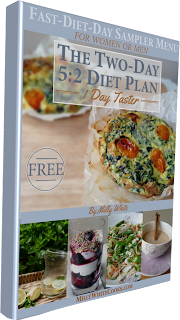 It contains all you need for 1 Delicious Fast Diet Day on the Two Day 5:2 Diet Plan, including:
It contains all you need for 1 Delicious Fast Diet Day on the Two Day 5:2 Diet Plan, including:a one day meal plan for women or men, with choices to suit those following a vegetarian or gluten-free dieta complete shopping listtasty & filling recipes for breakfast, lunch & dinnera comprehensive FAQs section to help you decide if this diet plan is right for youplus bonus drinks recipes for a delicious way to start and end your fast diet day.

Published on July 15, 2015 02:39
July 1, 2015
3 Fabulous Foods Rich in Beta Glucan 4 Lower Cholesterol – Love Your Heart!
Love your heart & take a closer look at these 3 fabulous foods that are rich in beta glucan for lower cholesterol!
 What is Beta Glucan?Beta glucan is a soluble dietary fibre found naturally in some foods and research has shown that it has a cholesterol lowering effect. In addition, soluble fibre is also known to help slow down the absorption of sugars from our diet, which means that beta glucan can also help to control blood sugar levels.
What is Beta Glucan?Beta glucan is a soluble dietary fibre found naturally in some foods and research has shown that it has a cholesterol lowering effect. In addition, soluble fibre is also known to help slow down the absorption of sugars from our diet, which means that beta glucan can also help to control blood sugar levels.
 Beta Glucan Triple PlayWith beta glucan, you get a triple whammy, as it works in three different ways to reduce cholesterol levels. By binding to bile and cholesterol together, beta glucan helps prevent the cholesterol-like substances in our bile from being reabsorbed.It helps prevent cholesterol in our food from being absorbedIt helps reduce the levels of cholesterol in our body by taking more cholesterol out of our blood stream.
Beta Glucan Triple PlayWith beta glucan, you get a triple whammy, as it works in three different ways to reduce cholesterol levels. By binding to bile and cholesterol together, beta glucan helps prevent the cholesterol-like substances in our bile from being reabsorbed.It helps prevent cholesterol in our food from being absorbedIt helps reduce the levels of cholesterol in our body by taking more cholesterol out of our blood stream.
3 Fabulous Foods Rich in Beta Glucan (2 of which are also Gluten-Free)All of that sounds great, but not so much if it means eating food with the taste and texture of cardboard! Luckily, you don't have too. The UK's leading cholesterol charity (link: HEARTUK.org.uk) advises that optimal intake is 3g or more of beta glucan daily. This can be achieved through eating 2-4 portions of foods rich in beta glucan, and here's the fabulous news - 3 excellent & delicious sources of beta glucan are:Oats Shiitake MushroomsPearl BarleyShiitake mushrooms and certified gluten-free oats are both great sources of beta glucan for those on a gluten-free diet, but barley is a form of wheat and should be avoided.
5 Really Delicious Ways To Eat More Beta Glucan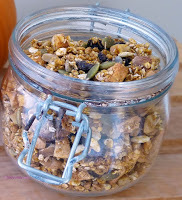 Make your own heart-healthy, oat-rich breakfast granolaSpeaking of granola, have you tried a savoury granola as a sprinkle over soup instead of croutons? Add sliced shiitake mushrooms to casseroles and saladsAdd a couple of spoons of pearl barley to soups and stewsWhizz a spoon of oats in with your fruit smoothie.Further InspirationIf you're looking for inspiring, low-cholesterol recipes, then you may want to checkout my best-selling Easy Low Fat & Low Cholesterol Mediterranean Diet Recipe Cookbook which features over 100 easy heart-healthy recipes.
Make your own heart-healthy, oat-rich breakfast granolaSpeaking of granola, have you tried a savoury granola as a sprinkle over soup instead of croutons? Add sliced shiitake mushrooms to casseroles and saladsAdd a couple of spoons of pearl barley to soups and stewsWhizz a spoon of oats in with your fruit smoothie.Further InspirationIf you're looking for inspiring, low-cholesterol recipes, then you may want to checkout my best-selling Easy Low Fat & Low Cholesterol Mediterranean Diet Recipe Cookbook which features over 100 easy heart-healthy recipes.
If you need to follow a gluten-free diet, you'll know that it can be both expensive and difficult to find shop-bought gluten-free breakfast foods that are also low fat and low cholesterol, such as gluten-free granola. That difficulty is easily solved with my Gluten Free & Wheat Free Diet Brunch & Breakfast Recipe Cookbook:
 What is Beta Glucan?Beta glucan is a soluble dietary fibre found naturally in some foods and research has shown that it has a cholesterol lowering effect. In addition, soluble fibre is also known to help slow down the absorption of sugars from our diet, which means that beta glucan can also help to control blood sugar levels.
What is Beta Glucan?Beta glucan is a soluble dietary fibre found naturally in some foods and research has shown that it has a cholesterol lowering effect. In addition, soluble fibre is also known to help slow down the absorption of sugars from our diet, which means that beta glucan can also help to control blood sugar levels. Beta Glucan Triple PlayWith beta glucan, you get a triple whammy, as it works in three different ways to reduce cholesterol levels. By binding to bile and cholesterol together, beta glucan helps prevent the cholesterol-like substances in our bile from being reabsorbed.It helps prevent cholesterol in our food from being absorbedIt helps reduce the levels of cholesterol in our body by taking more cholesterol out of our blood stream.
Beta Glucan Triple PlayWith beta glucan, you get a triple whammy, as it works in three different ways to reduce cholesterol levels. By binding to bile and cholesterol together, beta glucan helps prevent the cholesterol-like substances in our bile from being reabsorbed.It helps prevent cholesterol in our food from being absorbedIt helps reduce the levels of cholesterol in our body by taking more cholesterol out of our blood stream.3 Fabulous Foods Rich in Beta Glucan (2 of which are also Gluten-Free)All of that sounds great, but not so much if it means eating food with the taste and texture of cardboard! Luckily, you don't have too. The UK's leading cholesterol charity (link: HEARTUK.org.uk) advises that optimal intake is 3g or more of beta glucan daily. This can be achieved through eating 2-4 portions of foods rich in beta glucan, and here's the fabulous news - 3 excellent & delicious sources of beta glucan are:Oats Shiitake MushroomsPearl BarleyShiitake mushrooms and certified gluten-free oats are both great sources of beta glucan for those on a gluten-free diet, but barley is a form of wheat and should be avoided.
5 Really Delicious Ways To Eat More Beta Glucan
 Make your own heart-healthy, oat-rich breakfast granolaSpeaking of granola, have you tried a savoury granola as a sprinkle over soup instead of croutons? Add sliced shiitake mushrooms to casseroles and saladsAdd a couple of spoons of pearl barley to soups and stewsWhizz a spoon of oats in with your fruit smoothie.Further InspirationIf you're looking for inspiring, low-cholesterol recipes, then you may want to checkout my best-selling Easy Low Fat & Low Cholesterol Mediterranean Diet Recipe Cookbook which features over 100 easy heart-healthy recipes.
Make your own heart-healthy, oat-rich breakfast granolaSpeaking of granola, have you tried a savoury granola as a sprinkle over soup instead of croutons? Add sliced shiitake mushrooms to casseroles and saladsAdd a couple of spoons of pearl barley to soups and stewsWhizz a spoon of oats in with your fruit smoothie.Further InspirationIf you're looking for inspiring, low-cholesterol recipes, then you may want to checkout my best-selling Easy Low Fat & Low Cholesterol Mediterranean Diet Recipe Cookbook which features over 100 easy heart-healthy recipes.If you need to follow a gluten-free diet, you'll know that it can be both expensive and difficult to find shop-bought gluten-free breakfast foods that are also low fat and low cholesterol, such as gluten-free granola. That difficulty is easily solved with my Gluten Free & Wheat Free Diet Brunch & Breakfast Recipe Cookbook:
Published on July 01, 2015 07:10
June 27, 2015
Roasted Balsamic Tomatoes Recipe
 Roasted Balsamic Tomatoes RecipeThis Roasted Balsamic Tomatoes Recipe is simple & delicious but also very versatile. You can serve these tomatoes hot, straight from the oven or just warm or even completely cold. They can be served as a tapas style low-fat, heart-healthy snack or as a side dish to a main course, or as a salad accompainment at a BBQ. They’re naturally gluten-free, dairy-free, nut-free, oat-free, yeast-free and suitable for vegetarians and vegans!
Roasted Balsamic Tomatoes RecipeThis Roasted Balsamic Tomatoes Recipe is simple & delicious but also very versatile. You can serve these tomatoes hot, straight from the oven or just warm or even completely cold. They can be served as a tapas style low-fat, heart-healthy snack or as a side dish to a main course, or as a salad accompainment at a BBQ. They’re naturally gluten-free, dairy-free, nut-free, oat-free, yeast-free and suitable for vegetarians and vegans! Roasted Balsamic Tomatoes Recipe
 Roasted Balsamic Tomatoes Recipe Directions
Roasted Balsamic Tomatoes Recipe DirectionsPreheat the oven to 180C fan, 400F, Gas Mark 6 and place an oven-proof sauté pan in to warm.
Place the peeled garlic clove and 1/8 tsp of sea (kosher) salt into a pestle and mortar, if you have one. Grind these together to form a paste. If you don’t have a pestle and mortar, pop the garlic clove and salt onto a chopping board and simply use the flat side of a kitchen knife to work together into a paste and then transfer to a small bowl. Add the vinegar, dried herbs and black pepper and whisk together.
Cut the tomatoes in half. Remove the sauté pan from the oven and place the tomatoes in the pan, cut side up. Spoon over the vinaigrette dressing and place a basil leaf on top. Return the pan to the oven and cook for 15-20 mins until the tomatoes are softened. These can be served hot, warm or at room temperature.
FREE Recipe Card (PDF) & Free Snacks Recipe Booklet
If you'd like to keep this recipe for future reference, you can
download the Recipe Card (PDF) here.
This Roasted Balsamic Tomatoes Recipe is just one of the delicious snack recipes featured in my FREE Recipe Booklets. With a selection of savoury and sweet recipes for everyday healthy snacks, all you need to do is to choose which booklet you would like and tell me where to send it - details here.
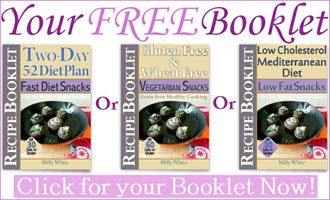
Published on June 27, 2015 07:55
June 21, 2015
Father's Day Quote - A Father is neither an Anchor
 Just wanted to share these wonderful words from the quote 'A Father is neither an anchor' and wishing all the great fathers out there a Happy Father's Day!
Just wanted to share these wonderful words from the quote 'A Father is neither an anchor' and wishing all the great fathers out there a Happy Father's Day! 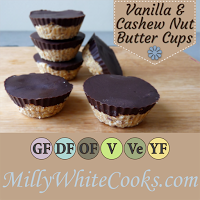 If you're looking for a quick, easy and delicious Father's Day gift idea, take a look at my gorgeous Vanilla & Cashew Butter Cup Chocolate receipe here.
If you're looking for a quick, easy and delicious Father's Day gift idea, take a look at my gorgeous Vanilla & Cashew Butter Cup Chocolate receipe here.
Published on June 21, 2015 01:20
June 20, 2015
Vanilla & Cashew Nut Butter Cup Cholocate Recipe
 Make a really special gift with these gorgeous Vanilla & Cashew Nut Butter Cups chocolates. Whilst these chocolates are most definitely an indulgent treat and not for daily consumption, these delicious morsels are actually much lower in saturated fat than shop-bought chocolates and are also rich in omega fatty acids. So if you love your Dad’s heart, try making these for a perfect gift, they are super-easy to make and taste absolutely divine. They’re also gluten-free, dairy-free, oat-free, yeast-free and suitable for vegetarians and vegans! They also make an excellent alternative to peanut buter cups or almond butter cups.
Make a really special gift with these gorgeous Vanilla & Cashew Nut Butter Cups chocolates. Whilst these chocolates are most definitely an indulgent treat and not for daily consumption, these delicious morsels are actually much lower in saturated fat than shop-bought chocolates and are also rich in omega fatty acids. So if you love your Dad’s heart, try making these for a perfect gift, they are super-easy to make and taste absolutely divine. They’re also gluten-free, dairy-free, oat-free, yeast-free and suitable for vegetarians and vegans! They also make an excellent alternative to peanut buter cups or almond butter cups.Recipe
 DirectionsPlace the cashew nuts into a roasting dish and coat in 1 tsp coconut oil. Place in the oven and roast for 13-15 mins until lightly golden, then remove from oven. Spread the roasted nuts onto a clean plate and allow to cool for 10 mins. Meanwhile, mix together the coconut and ground flaxseeds. Place into a heatproof baking dish and roast in the oven for 7-10 mins until also lightly golden and toasted.
DirectionsPlace the cashew nuts into a roasting dish and coat in 1 tsp coconut oil. Place in the oven and roast for 13-15 mins until lightly golden, then remove from oven. Spread the roasted nuts onto a clean plate and allow to cool for 10 mins. Meanwhile, mix together the coconut and ground flaxseeds. Place into a heatproof baking dish and roast in the oven for 7-10 mins until also lightly golden and toasted.Once the roasted nuts have cooled, place into the bowl of a food processor. Scrap in the seeds scrapped from the vanilla pod. Process until the nuts become a smooth butter (this will take 5-10 mins, you’ll need to turn off and scrape down the sides 1-2 times and you may also need to give your food processor a little rest between sessions if it doesn’t like being switched on for long periods).
Whilst the nut butter is processing, break the chocolate into a heatproof bowl and melt over a pan of barely simmering water (making sure the bottom of the bowl is not in contact with the water).
Once smooth, scrape the cashew nut butter into a bowl and mix in the vanilla extract and maple syrup. Then add the toasted coconut and milled flaxseed and mix well to combine.
I have a silicone chocolate mold which I used, but if you don’t have these just use 16 sweet paper cases. Spoon 1 tsp of the cashew butter mix into each mold/case pat down with a clean finger. Spoon 1 tsp of melted dark chocolate over each butter cup. Chill for at least 2 hrs, then keep refrigerated until eaten.
FREE Recipe Card (PDF) & Free Snacks Recipe BookletIf you'd like to keep this recipe for future reference, you can download the Recipe Card (PDF) here.
Whilst these delicious Vanilla & Cashew Nut Butter Cup Cholocates are an indulgent treat better reserved for special occasions, if you would also like a FREE Recipe Booklet with receipes for everyday healthy snacks, then you just need to choose which booklet you would like and tell me where to send it - details here.
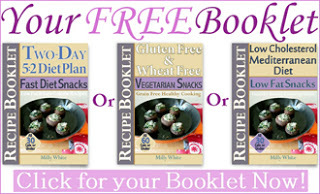
Published on June 20, 2015 03:33
Father's Day Special - Vanilla & Cashew Nut Butter Cup Cholocate Recipe
 Make Father’s Day really special with these gorgeous Vanilla & Cashew Nut Butter Cups. Whilst these chocolates are most definitely an indulgent treat and not for daily consumption, these delicious morsels are actually much lower in saturated fat than shop-bought chocolates and are also rich in omega fatty acids. So if you love your Dad’s heart, try making these for a perfect gift, they are super-easy to make and taste absolutely divine. They’re also gluten-free, dairy-free, oat-free, yeast-free and suitable for vegetarians and vegans!
Make Father’s Day really special with these gorgeous Vanilla & Cashew Nut Butter Cups. Whilst these chocolates are most definitely an indulgent treat and not for daily consumption, these delicious morsels are actually much lower in saturated fat than shop-bought chocolates and are also rich in omega fatty acids. So if you love your Dad’s heart, try making these for a perfect gift, they are super-easy to make and taste absolutely divine. They’re also gluten-free, dairy-free, oat-free, yeast-free and suitable for vegetarians and vegans!Recipe
 DirectionsPlace the cashew nuts into a roasting dish and coat in 1 tsp coconut oil. Place in the oven and roast for 13-15 mins until lightly golden, then remove from oven. Spread the roasted nuts onto a clean plate and allow to cool for 10 mins. Meanwhile, mix together the coconut and ground flaxseeds. Place into a heatproof baking dish and roast in the oven for 7-10 mins until also lightly golden and toasted.
DirectionsPlace the cashew nuts into a roasting dish and coat in 1 tsp coconut oil. Place in the oven and roast for 13-15 mins until lightly golden, then remove from oven. Spread the roasted nuts onto a clean plate and allow to cool for 10 mins. Meanwhile, mix together the coconut and ground flaxseeds. Place into a heatproof baking dish and roast in the oven for 7-10 mins until also lightly golden and toasted.Once the roasted nuts have cooled, place into the bowl of a food processor. Scrap in the seeds scrapped from the vanilla pod. Process until the nuts become a smooth butter (this will take 5-10 mins, you’ll need to turn off and scrape down the sides 1-2 times and you may also need to give your food processor a little rest between sessions if it doesn’t like being switched on for long periods).
Whilst the nut butter is processing, break the chocolate into a heatproof bowl and melt over a pan of barely simmering water (making sure the bottom of the bowl is not in contact with the water).
Once smooth, scrape the cashew nut butter into a bowl and mix in the vanilla extract and maple syrup. Then add the toasted coconut and milled flaxseed and mix well to combine.
I have a silicone chocolate mold which I used, but if you don’t have these just use 16 sweet paper cases. Spoon 1 tsp of the cashew butter mix into each mold/case pat down with a clean finger. Spoon 1 tsp of melted dark chocolate over each butter cup. Chill for at least 2 hrs, then keep refrigerated until eaten.
Download a PDF Recipe Card here.
Published on June 20, 2015 03:33
June 16, 2015
Chocoholics Are Celebrating – New Research Finds Eating Chocolate Is Good for Heart Health!
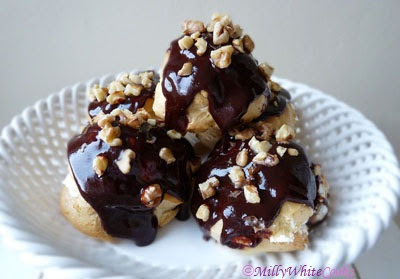 Gluten Free Choc Nut Choux BunsCan you hear the loud cheering? It’s the sound of chocoholics across the world cheering at the news that eating up to 100g of chocolate every day is linked to lowered heart disease and stroke risk!
Gluten Free Choc Nut Choux BunsCan you hear the loud cheering? It’s the sound of chocoholics across the world cheering at the news that eating up to 100g of chocolate every day is linked to lowered heart disease and stroke risk! In research published in the Heart online journal (link: heartjnl-2014-307050) , researchers at the University of Aberdeen have concluded that there doesn’t seem to be any evidence for cutting out chocolate to lower the risk of cardiovascular disease. Quite the reverse, they found that when compared with the 1-in-5 people in the study who ate no chocolate, chocolate eaters were linked to an:
11% lower risk of cardiovascular disease23% lower risk of stroke
And they point out that as more milk chocolate was eaten than dark chocolate, they are not restricting their conclusions to the dark chocolate only, which has traditionally been considered to be "healthier"!
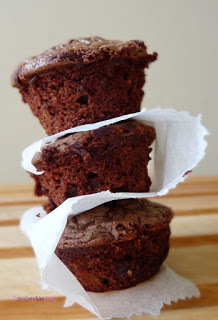 Low Fat Brownie BitesTheir Research Conclusion
“Cumulative evidence suggests that higher chocolate intake is associated with a lower risk of future cardiovascular events.”
Low Fat Brownie BitesTheir Research Conclusion
“Cumulative evidence suggests that higher chocolate intake is associated with a lower risk of future cardiovascular events.”
How Robust is the Study?The researchers at researchers at the University of Aberdeen have drawn their conclusions from two main sources. Firstly, they analysed the impact of diet on the long term health on adults over a 12 year period (21,000 adults). They also completed a systematic peer review of nine existing internationally published studies that looked at the links between chocolate and cardiovascular disease, (totalling almost 158,000 people, including the 21k in their own study).
3 Reasons Why We Should Cautious About ThisBy their own admission, the researchers have added their own health-warnings to this heart-health study!
They make the point that as this was an observational study, they cannot draw any definitive conclusions about cause and effect. They also acknowledge that food frequency questionnaires do involve a certain amount of recall bias and underestimation of items eaten.Finally, they draw attention to something called “reverse causation”. This is whereby those with a higher cardiovascular disease risk profile may eat less chocolate and foods containing it than those who are healthier and this may also help to explain their findings.Nevertheless, they conclude: “There does not appear to be any evidence to say that chocolate should be avoided in those who are concerned about cardiovascular risk.”
Looking for Chocolate Inspiration?
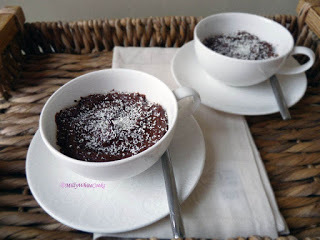 Lower Fat Dark Chocolate PotsAs I'm a firm believer in following a balanced diet that does allow healthier treats and occassionally includes really indulgent, celebratorty feasts, you may want read my blog posts:
Lower Fat Dark Chocolate PotsAs I'm a firm believer in following a balanced diet that does allow healthier treats and occassionally includes really indulgent, celebratorty feasts, you may want read my blog posts: Perfectly Portioned
Ultimate Gluten-Free Chocolate Recipes
Published on June 16, 2015 04:53



